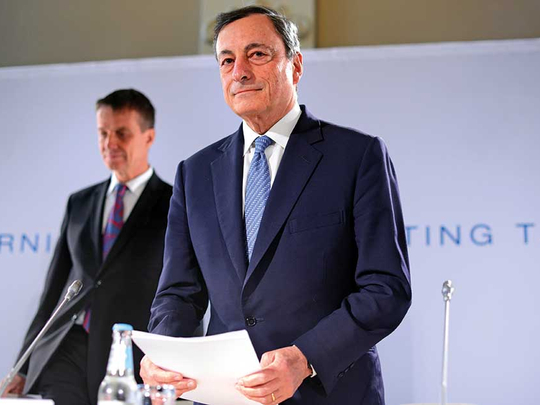
FRANKFURT: European Central Bank policy makers are wondering how much stimulus quantitative easing offers once bond-buying stops.
Their assessment will likely influence the ECB’s strategy for ending its asset-purchase programme. Keen to avoid any steps that inadvertently tighten financial conditions, policy makers can’t ignore that their open-ended QE design so far means investors are focused more on the monthly flow of acquisitions than the stock of debt accumulated in the past three years.
“Markets are trying to understand the ECB’s broader thinking when they read the flow of purchases,” said Jamie Murray, an economist at Bloomberg Intelligence in London. “While the stock is delivering the vast bulk of stimulus, changes to the flow may tell you something about when interest rates could start to rise.”
The ECB’s current tack puts every official remark under the microscope. Policy makers are aware of the challenge of communicating an exit from QE, and have held an extensive discussion about stock-versus-flow effects, according to people familiar with the debate. An account of the July 19-20 Governing Council meeting showed members asked that the topic should “be considered.”
The people asked not to be named because internal discussions are confidential. An ECB spokesman declined to comment.
There was a time when President Mario Draghi appeared to lean toward a definite goal for purchases, signalling in September 2014 that the ECB’s balance sheet would be expanded by about 1 trillion euros (Dh4.4 trillion) to stave off the threat of deflation.
The balance sheet has since expanded by more than twice as much after that promise morphed into monthly targets — currently 60 billion euros — with no definite end. The Governing Council’s guidance that buying can be increased “in terms of size and/or duration” if the outlook worsens is further feeding investors’ interest in the QE flow, as is the ECB’s reinvestment of maturing debt.
Since March, the central bank has rolled over some 10.7 billion euros, according to ABN Amro, a number it estimates could increase to 640 billion euros by the end of 2020.
Draghi has so far remained elusive on what happens next, promising only that purchases won’t stop abruptly, and that a decision will be made in the fall. Most economists expect him to announce that QE will continue at a reduced pace starting early next year, and be gradually phased out before the end of 2018.
If the ECB chief wants to set out the intellectual framework for the Governing Council’s discussions at its next meeting on September 7, he has at least two platforms to do so. He’ll speak in southern Germany on August 23 and two days later will address the US Federal Reserve’s symposium in Jackson Hole, Wyoming.
His current approach echoes the strategy the Fed used in its third QE programme from 2012 to 2014. While then-Chairman Ben Bernanke was able to calibrate the stimulus based on incoming data, his first suggestion that purchases might be tapered sent global markets into ructions.
Draghi had a similar experience in June when he argued that the strengthening economic recovery could allow the central bank to adjust its policy parameters. That was taken as a sign that tapering is on the table, sending the euro and bond yields soaring, and prompting the ECB to say investors had overinterpreted the message.
When Draghi was asked last year how the stock-versus-flow theory would impact the unwinding of monetary stimulus, he said the Governing Council hadn’t discussed the matter.
Since then, the issue has bubbled beneath the surface. Some council members are concerned that the effect of QE will fade when purchases end, according to one of the euro-area officials.
Others disagree. Estonia’s Ardo Hansson, one of the more hawkish members, said in an interview with business paper Aripaev published this week that “by now, the economy is mainly supported not by monthly bond purchases but by the central-bank balance sheet.”
In hindsight, the ECB’s emphasis on flow rather than stock since it started buying government bonds impeded its exit strategy from the beginning and was probably misjudged, according to a former member of the Governing Council, speaking on condition of anonymity because of the sensitivity of the matter.
The Bank for International Settlements, which has monitored central banks’ quantitative-easing programmes since their inception, most recently addressed the matter in global terms in its 2017 annual report, noting the implications for any exit strategy.
“The prevailing view among economists is that stocks matter most for asset prices” but “it is also possible that flows matter — a view that has some currency among market participants,” the institution said. “Concerns with flow effects would induce central banks to pay more attention to smoothing out actual transactions and would strengthen the case for gradualism.”












